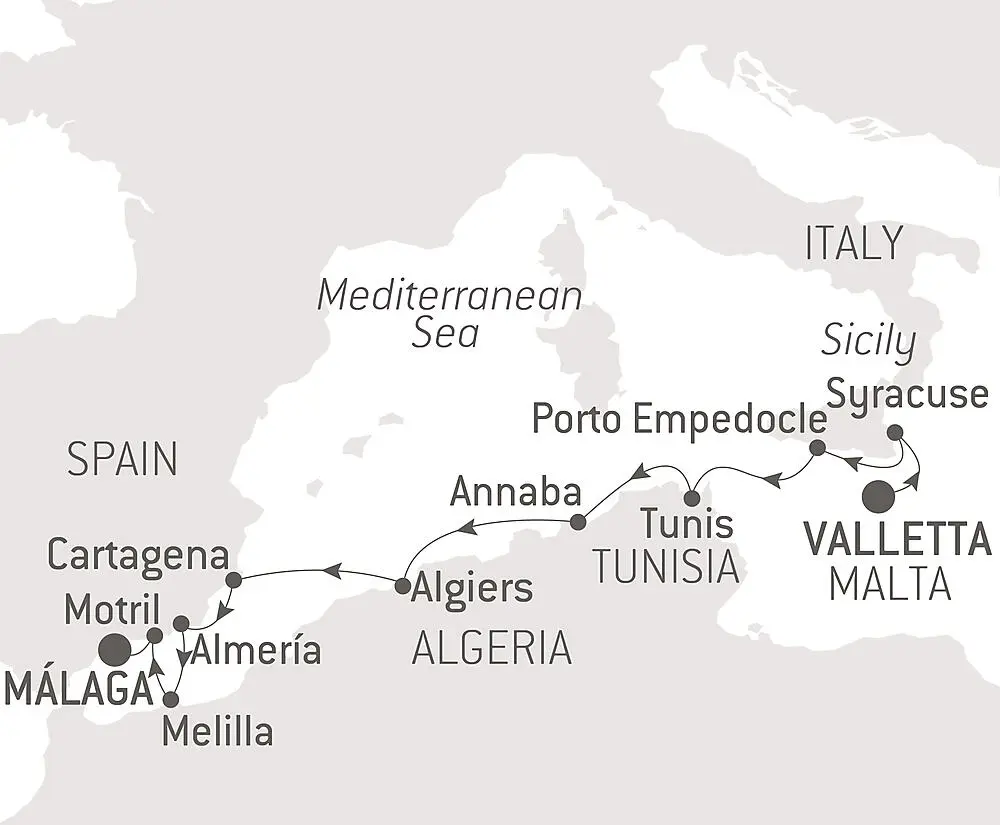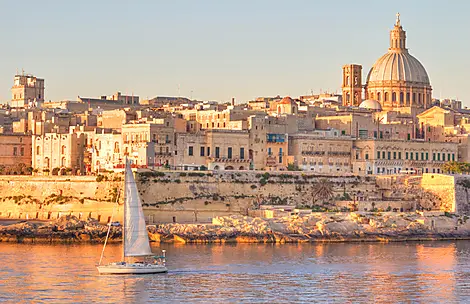
Ancient shores of the Mediterranean

Valletta (Malta) - Malaga
Duration: 11 Days
Boats: Le-Bougainville
Sailing Date : Oct 31 2026
Itinerary

Day 1 - Valletta
The whole of the Maltese capital Valletta is UNESCO World Heritage listed and occupies a peninsula in the north-east of the island. From the fountain of Tritons to Saint-Elme fort, there are as many majestic streets as there are narrow staircase vennels to explore. The painted loggia and carved corbels on the tall houses will accompany you in your explorations, and you’ll rarely be bothered by traffic. You can visit the Grandmasters palace decorated with coats of arms and frescoes. Saint-John’s cathedral and the ramparts which have guarded the city since the 16th century are also among the most emblematic sites of the city. Arranged in terraces, the Barrakka Gardens will punctuate your promenade with a green and floral experience.

Day 2 - Syracuse, Sicily
Its undulating rocky coastline, the endless sandy beaches, the menacing form of Mount Etna which surveys its island like a patriarch, the flowery gardens on the hillside... Sicily lays out its varied landscapes like a shopkeeper displays his wares. Described by Cicero as “the most beautiful city in the world”, Syracuse was one of the most prestigious cities in Sicily and at her height was even a rival for Athens. A central city of Ancient Greece, it was home to a succession of civilisations, each of which has left their mark. The blend of Arabic, Roman, Norman, Byzantine and Spanish cultures makes Syracuse a town that is extraordinarily rich in fragrances, colours and flavours.
2 available excursions
Archaeological site & Ortygia, Noto, Baroque Town

Day 3- Porto Empedocle, Sicily
Huddled on the south-western coast of Sicily, Porto Empedocles bears the name of the philosopher Empedocles, who lived in the region in the 5th century BC. An age-old city offered up to sun and sea, this is your doorway to the exceptional archaeological site of Temple Valley, a high place of Greek civilisation listed as a UNESCO World Heritage site. You can admire the remains of many temples dedicated to Zeus, his wife Hera and Hephaestus. Make sure you take in the magnificent Italian countryside, with its olive orchards that cover the hillsides.
1 available excursions
Valley of the Temples and Casa Barbadoro

Day 4 - Tunis
At the crossroads of civilisations, the capital of Tunisia is rich in cultural discoveries. The ruins of Ancient Carthage, a UNESCO World Heritage Site and particularly well preserved, testify to the splendour of this city that was once Rome’s great rival. The hill of Byrsa, the former fortified citadel of the Phoenician port and one of the presumed burial places of Saint Louis who died there during the Eighth Crusade, offers spectacular views over the Gulf of Tunis. In the Bardo National Museum, you will be able to admire one of the world’s finest Roman mosaic collections, including the magnificent portrait of the poet Virgil.

Day 5 - Annaba
Annaba, a coastal town in eastern Algeria, is the country's fourth largest city. It contains many heritage treasures, including the ancient site of Hippo, the largest Roman forum in Africa. From the Cap de Garde lighthouse, you get a splendid and varied panoramic view with mountains and sea, while the basilica of Saint Augustine, the bishop of Hippo in the 4th century, overlooks the city with its majestic white dome. A stroll along the Corniche and the Cours de la Révolution will introduce you to the lively, elegant town that inspired numerous artists and writers.

Day 6 - Algiers
The beauty of the Bay of Algiers offers travellers arriving by sea an unforgettable view. The Casbah houses cascade down to the Haussmann-style buildings and the hustle and bustle of the Mediterranean city creates a unique atmosphere. Algiers the White proudly bears the traces of its history with its magnificent Casbah, listed as UNESCO World Heritage, its tropical garden called Jardin d’Essai, its Martyr’s Memorial, its imposing Basilica of Our Lady of Africa, and its lively city centre with its Grande Poste (main post office) and French quarter. Seventy kilometres (43 miles) away, you will have the possibility of visiting Tipaza, one of the most extraordinary archaeological complexes of the Maghreb, listed as World Heritage by UNESCO. Once a trading post of the Carthaginians and later the Romans, the ancient city is home to the Royal Mausoleum of Mauretania, a funerary monument providing precious evidence of what was once the Punic world.

Day 7 - Cartagena
Surrounded by hills, the natural site of the Bay of Carthagena presided over the fate of this former fortress which has been home to the greatest European civilisations. Today, these Phoenician, Roman, Carthaginian, Moorish and Christian influences form a rich architectural heritage. Its Roman theatre is one of the most significant and best conserved in Spain. You will also be able to cross the landscapes of vines and citrus groves stretching endlessly towards Murcia, to visit this dynamic regional capital.
1 available excursions
Horses of Spain, Cartagena & Roman theater

Day 8 - Almeria
On the Mediterranean shore, the easternmost Andalusian capital, the legendary Almería (from the Arab Al-Mariy-yat, meaning watchtower), has a coastline of preserved beaches with an interior characterised by its typical desert ecosystem. In the past an important port for the Caliphate of Córdoba, Almería has a remarkable citadel and a cathedral whose imperious structure stands in the very centre of the old town. This old town, with its narrow streets, will charm you with its lime washed walls and its rich historical and cultural heritage.

Day 9 - Melilla
An autonomous city of Spain on the North African coast, Melilla and its citadel sit on the edge of Cape Three Forks, between Morocco and the Mediterranean Sea, offering breathtaking views of this blue expanse. A perfect blend of history and modernity, the city boasts charming cobbled streets, imposing ramparts and a number of historic sites that are well worth a visit, including the Baluarte de la Concepción and the Hospital del Rey. In contrast to these vestiges of the city's military past, the Art Nouveau curves of the Palacio de la Asamblea, Casa Melul, the Reconquista building and Plaza Menéndez Pelayo reflect the influence of Gaudi's student Enrique Nieto, who lived here, and the great Catalan Modernist period. After Barcelona, Melilla has the largest number of buildings in this style.

Day 10 - Motril
On the shores of the Mediterranean, Motril enjoys a special place on the Costa Tropical. Sheltered from the cold northerly winds thanks to the mountains that surround this Andalusian city, the city benefits from an ideal micro-climate.

Day 11 - Malaga
A historical and festive town, Malaga is located in Andalusia, on the Costa del Sol. Between the marina and the beaches, the seaside promenade of La Farola offers an ideal setting for strolling and relaxing. Set slightly further back, the Malagueta bullring is one of the emblematic sites of the city. From the hill overlooking the old town, one can see Gibralfaro castle and the Alcazaba, two fortified ensembles rising out from the cypresses and maritime pines. To visit Pablo Picasso’s birthplace, you will go first to the courtly plaza de la Merced. A few streets back from here, you can explore the museum dedicated to the artist, in the Buenavista palace.

